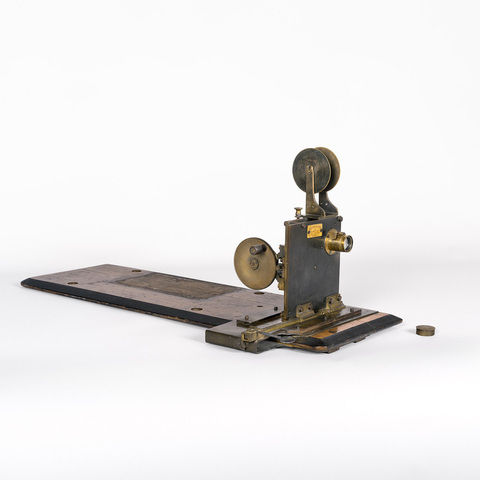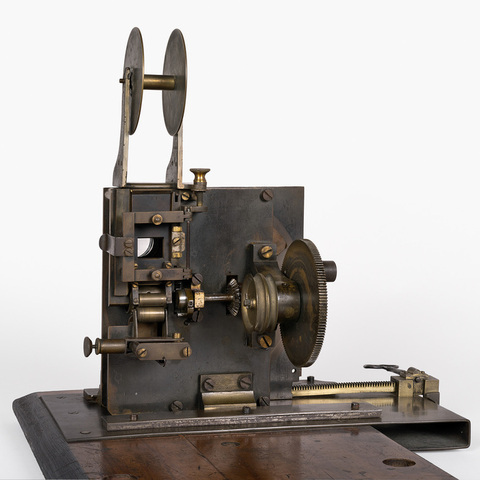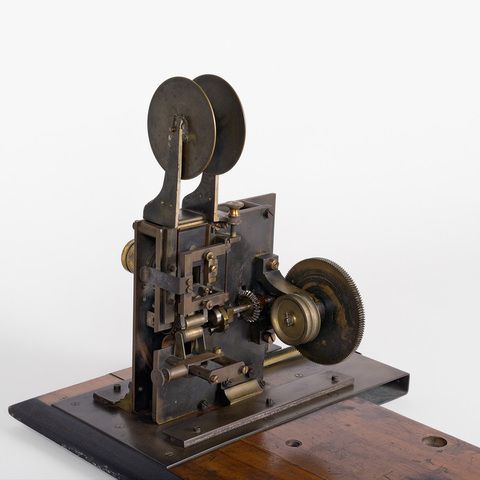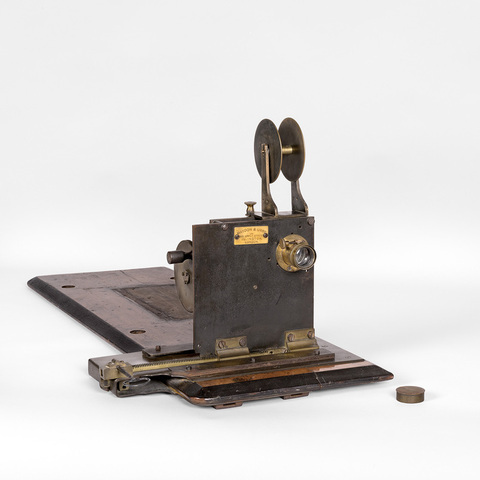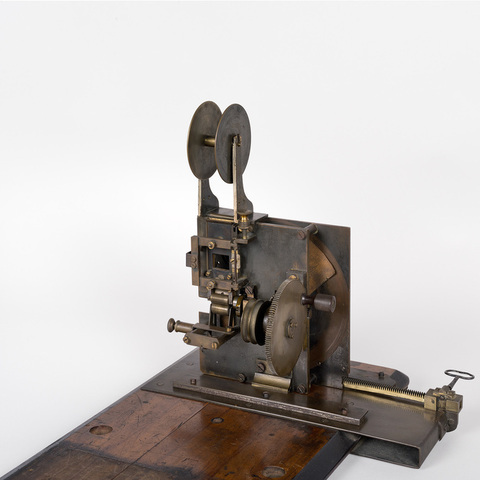Projecteur de film 35 mm
Fiche détaillée
Type de l'appareil
entraînement du film 35 mm par une croix de Malte à cinq branches ; obturateur à une pale en carton ; un débiteur denté ; couloir presseur ; fenêtre réglable en hauteur ; objectif à crémaillère avec vis réglable ; support de bobine ; manivelle ; projecteur monté sur une planche en bois, réglage horizontal grâce à une crémaillère avec clé
Auteurs
Haydon George
Londres, 22 & 23 Church Street
Urry Frank Harvey
Londres, 22 & 23 Church Street
Sommerville George
Fabricants
George Haydon
Londres, 22 & 23 Church Street
Frank Harvey Urry
Londres, 22 & 23 Church Street
George Sommerville
Londres, 22 & 23 Church Street
Utilisateurs
Haydon George
Londres, 22 & 23 Church Street
Urry Frank Harvey
Londres, 22 & 23 Church Street
Sommerville George
Distributeurs
Haydon & Urry LTD
Londres, 353 Upper Street
Sujet du modèle
Informations non disponibles
Objectif
3 cm diamètre
Taille de l'objet
Ouvert :
Informations non disponibles
Fermé :
Longueur : 88 cm
Largeur : 40.5 cm
Hauteur : 40 cm
Diamètre :
Informations non disponibles
Taille de la boîte de transport
Informations non disponibles
Remarques
Marque ivoire : "Haydon & Urry LTD, 353 Upper Street Islington, London".
Le premier modèle de l'Eragraph figure dans la collection Barnes (daté c. 1897) ; le deuxième est conservé au Science Museum et chez Barnes (1897 ; la manivelle est sur la roue de droite) ; une publicité le reproduit dans The Magic Lantern Journal Annual 1898-1899. Ce modèle précis doit être l'un des derniers produits en 1898.
Voir autre exemplaire : AP-94-86.
Haydon and Urry Limited a été créé en 1893 par George Haydon, Frank Harvey Urry, George Sommerville pour la fabrication et vente de systèmes mécaniques, gazomètres, phonographes, polyphones, machines automatiques. D'abord installé 31 Furnival Street à Londres en 1894-1895, puis au 34 Gray's Inn Road en 1896, ils installent en décembre 1896 des bureaux et un magasin au 353 Upper Street. En 1897, une production de films commence (ouverture d'un petit studio, 20 et 22 Church Street, adjacent au magasin d'Upper Street).
"The Eragraph (1898 improved model). The Kinematograph of the era. Essentially the apparatus for the professional exhibitor. Gold Medal, Trades and Arts Exhibition, Wigan, 1897 ; Dunfermline Scientific Exhibition, 1897, and numerous other awards. Of accurate and high-class workmanship. Strongly and scientifically made to stand the wear and tear of every and all day use. Mechanism extremely simple and compact, but without sacrificing any essential feature of a perfect apparatus. Built to take Edison Standard films and perforations. Exhibited with complete success at the London Pavilion, Empire, and all principal Theatres and Halls in London and Provinces. Now in use by the most prominent Exhbitors in the Kingdom" (publicité publiée dans Magic Lantern Journal Annual 1898-1899).
"One of the most popular projecting machines sold to the travelling fair ground showman from 1896 onwards was the Eragraph, manufacted and marketed by Haydon & Urry, at their works in Upper Street Islington, directly opposite the Agricultural Hall. Monti Williams, the son of the great veteran showman, Randall Williams, who was connected with the firm at that time, was responsible in a great measure for bringing this projector into being. Having a show booth with some Edison's Kinetoscopes installed, and hearing of the wonderful display of moving pictures being shown by Mons. Trewey at the Polytechnic for Lumiere, this alert showman made it his business to obtain an interview with Trewey, and upon his request being granted he was allowed to see the apparatus at work. Monti Williams was very quick to grasp the details of the projecting mechanism, and made a hurried sketch of the movement and also secured a small cutting of the film from Trewey. With this knowledge in his possession, he hurried back to Mr. George Haydon, who was a very clever mechanical engineer. Upon comparing the piece of film in use by Trewey with that made by Edison for the Kinetoscope, the guage was found to differ and also the perforation holes. Having obtained a good idea of the mechanism needed to impart an intermittent movement to the film, Mr. Haydon made a search at the Patent Office, to find a satisfactory motion that he could apply for this purpose, and this he discovered in the Maltese Cross movement with a locking cam and striking pin as applied for use in a cotton spinning jenny, patented for use in Rylands cotton spinning mills. He was not long in adapting this movement to a projector which he completed and placed upon the market. His first machines were ready in May 1896, when he sold the machines assisted by Mr. Urry, under the name of Eragraph, and the name of Haydon and Urry soon became famous for the supply of both projectors, films and accessories. It was with one of these projector mechanism fitted into a light tight box which served as a camera that Monti Williams journeyed across the Continent to Cannes Harbour in June 1896 and secured the first film of royal personage ever taken on a moving picture camera, viz, that of H. R. H. The Prince of Wales, later King Edward VII, when on board his yacht, the Britannia. [...] The Eragraph was the first projector to be installed and used by Felix Glenister at the London Pavilion in 1896, where it ran in competition with the Empire and Alhambra Theatres, being operated by Signor Polverina and Fred Griffiths. Another clever feat accomplished by Monti Williams was to film Queen Victoria's Diamond Jubilee in 1897, and show it the same night at the London Pavilion [...]" (Will Day, 25 000 Years to Trap a Shadow, tapuscrit, archives Cinémathèque française).
Bibliographie
J. Barnes, The Rise of the Cinema in Great Britain, Londres, 1983, pp. 66-69.
Magic Lantern Journal Annual 1898-1899.
